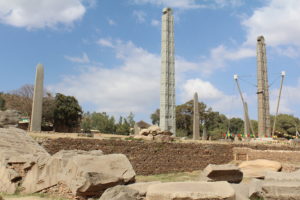When planning our Ethiopian trip, we were undecided about whether to include the northern city of Axum mainly because it involved what would be the only internal flight of our trip and a single night’s stay.
However, on reading that it was the first royal capital and one of the oldest continuously inhabited places in Africa with a naval and trading power that ruled the region from about 400 BC into the 10th century, we felt it was a must. It’s also said to be the home of the original Ark of the Covenant.
Our first stop was a church compound of the Cathedral of Tsion Maryam. We could just about make out the ruins of the original 4th century Maryam Tsion church through all the undergrowth.
Next was what our guide book described in one line as a ‘contemporaneous eyesore built by Haile Selassie’. However, I rather liked the large circular modern church built in the 1960s and visited by Queen Elizabeth). It had modern squares panes of stained glass and no pews or chairs – just an empty space as even though mass lasts all night, people have to stand. There were a lot of modern paintings on the same religious themes as we’d seen in other churches. A parchment book, enclosed in two layers of cloth, was opened for us by two men who showed us the brightly coloured drawings.
There was a rather dark small museum built by Haile Selassie’s wife with many crowns, crosses, religious relics, parchments and robes which had been donated by previous emperors.
There was also the church where the real Ark of the Covenant is housed and one next too it built in a similar style called the Church of Arbuta Insesa but we couldn’t go in either.
Then Roy was allowed into the oldest functioning church where wall paintings were revealed to him from behind curtains.
We then drove 2km out of town to a hilltop to see the tombs of Kaleb and Gebre Meskel which had been constructed using huge pieces of granite. The rumour is that a secret tunnel goes from the tombs all the way to Eritrea.
On the way back to our hotel for lunch we passed the Queen of Sheba’s swimming pool: a very uninspiring large rectangular expanse of muddy looking water with steep concrete sides. Nearby in a small makeshift hut with a stone slab was what was called the Ezana stone, discovered by three local men in a field, with an inscription in Sabean, Greek and Ge’ez promising an untimely death to anyone who moves it.
Our afternoon was spent at the Stelae fields. There were three particularly impressive stelae: the first credited to the 3rd century King Remhai lay crumpled on the ground in a number of pieces. At one part we walked under it and realised how wide it was. There are various rumours about why it collapsed, with one theory being that the base was not large enough to support the 33m granite column. The second Stelae, standing at 26m, had been looted by the Italians and taken to Rome – unfortunately in three pieces. Through diplomatic negotiations in early 2000, it was now back on its original site – in one piece. The third had scaffolding surrounding it to shore it up. There were about 70 to 100 stelae of various shapes and sizes but none of the others as well defined with their carved doors at the base and windows at a number of levels.
We also climbed down into the tomb of Remhai which had a number of rooms and didn’t require us to crouch. It still has Remhai’s closed stone coffin in it. This visit included a large museum comprising of various rooms with exhibits labelled in English although photographs were not allowed. It is still a mystery how the stelae were transported from the granite quarry 4km away, carved with such precision and then erected.
For our last visit of the day we drove to the palace ruins of the Queen of Sheba (we’d seen a model in the museum). There was a high covered viewing terrace to get a perspective of the whole 50 roomed site. Then we explored some of the ruins before hopping across the road to another, but less formed Gudit Stelae field.
This was a full day of sightseeing and well worth the internal flight and overnight stay.








